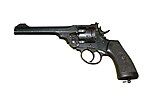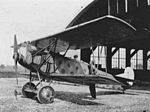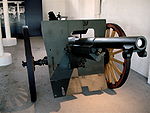Portal:World War I/Selected equipment
Selected equipment
The use of poison gas in World War I was a major military innovation. The gases used ranged from disabling chemicals such as tear gas and the more severe, mustard gas to killing agents like phosgene. This chemical warfare was a major component of the first global war and first total war of the 20th century. The killing capacity of gas was limited — only 3% of combat deaths were due to gas — however, the proportion of non-fatal casualties was high and gas remained one of the soldiers' greatest fears. In that it was possible to develop effective countermeasures to gas, it was unlike most other weapons of the period. Hence in the later stages of the war as the use of gas increased, in many cases its effectiveness was diminished. This widespread use of these agents of chemical warfare, and wartime advances in the composition of high explosives, gave rise to an occasionally expressed view of World War I as "the chemists' war".
Read more...The Webley Revolver (also known/referred to as the Webley Break-Top Revolver or Webley Self-Extracting Revolver) was, in various marks, the standard issue service pistol for the armed forces of the United Kingdom, the British Empire, and the Commonwealth from 1887 until 1963.
The Webley service revolver was most notably used in World War I (as the Webley Mk VI), although it had actually been adopted in 1887 (as the Webley Mk I) and risen to prominence during the Boer War of 1899-1902 (as the Webley Mk IV), and were of the "top-break" variety (breaking open much like a double-barrel shotgun to be reloaded), with the advantage of also being self-extracting—the act of breaking the revolver open also operated the extractor, removing the spent cartridges from the cylinder.
Firing the hard-hitting .455 Webley cartridge, the Webley service revolvers are the most powerful of the top-break revolvers ever produced. Although the .455 calibre Webley is no longer in military service, the .38/200 Webley Mk IV variant is still sporadically in use as a police sidearm in a number of countries.
Read more...The Tank was one of the most significant innovations of the First World War. The fighting conditions on the Western Front during the war prompted the British Army to begin research into a self-propelled vehicle which could cross trenches, crush barbed wire, and would be impervious to fire from machine-guns. Having already seen a Rolls-Royce Armoured Car used by Royal Naval Air Service in 1914, and aware of schemes prompted by Major Ernest Swinton to create a tracked fighting vehicle, First Lord of the Admiralty Winston Churchill sponsored the Landships Committee to oversee development of this new weapon. The Landships Committee created the first successful prototype tank, nicknamed Little Willie, which was tested by the British Army in September 1915. Although initially termed landships by the Admiralty, the initial vehicles were colloquially referred to as water carriers, later shortened to tanks, to preserve secrecy. The word tank was used to give the workers the impression they were constructing tracked water containers for the British army in Mesopotamia, and the name became official in December 1915.
Read more...The Vickers machine gun or Vickers gun is a name primarily used to refer to the water-cooled .303 inch (7.7 mm) machine gun produced by the Vickers Limited company, originally for the British Army. The machine gun typically required a six to eight-man team to operate: one to fire, one to feed the ammunition, and the rest to help carry the weapon, its ammunition and spare parts.
The gun had a reputation for great solidity and reliability. Ian V. Hogg, in Weapons & War Machines, describes an action that took place in August, 1916, during which the 100th Company of the Machine Gun Corps fired their ten Vickers guns continuously for twelve hours. They firing a million rounds between them, using one hundred new barrels, without a single breakdown. "It was this absolute foolproof reliability which endeared the Vickers to every British soldier who ever fired one."
Read more...The Fokker D.VII was a late World War I fighter aircraft designed by Reinhold Platz at the Fokker company. When introduced into combat in 1918, it quickly proved to be superior to existing Allied fighters, leading to a second Fokker Scourge. So infamous was the airplane, that it was the only weapon specifically mentioned by name by the Allies in the armistice agreements at the end of the war (Surrender in good condition by the German Armies of [...] all aircraft of the D7 type [...]).
Read more...The French 75mm field gun is a quick-firing field artillery piece developed before World War I and serving into World War II. It was commonly known as the French 75, or at times simply the "75" or "Soixante Quinze." It introduced, for the first time in field artillery history, a hydro-pneumatic recoil mechanism which permitted very high rates of fire while the gun's aim remained unaffected by the recoil. It was entirely manufactured at State-controlled arsenals, principally at "Atelier de Construction de Puteaux". The French 75's official designation was: Materiel de 75mm Mle 1897. It is not to be confused with the Schneider manufactured "Canon de 75mm Mle 1912" used by French cavalry, and its 1914 modification. Although they fired the original French 75's ammunition, these privately manufactured Schneider guns were lighter, smaller and mechanically different.
Read more...The Gewehr 98 was the standard German infantry rifle from 1898 to 1935, when the Karabiner 98k replaced it. The Gewehr 98, or G98, named for 1898, the first year of its manufacture, superseded the earlier Model 1888 Commission Rifle (also known as Gewehr 88 or Judenflinte) in German service. This should not be confused with a Mauser Model 1888. The G98 itself was the latest in a line of Mauser rifles that were introduced in the 1890s. It was a bolt-action rifle, 1.25 metres in length and 4.09 kilograms in weight. It carried 5 rounds of 7.92 x 57 mm Mauser ammunition in an internal box magazine.
Read more...Trench knives are either purpose-made weapons, or are made from cut-down (shortened) bayonets or swords, and intended for close-quarter fighting, the design originating in the trench warfare of the First World War. They were particularly useful for trench raiding operations, along with other mêlée weapons.
Read more...The Lewis Gun is a pre-World War I era squad automatic weapon/machine gun of American design that was most widely used by the forces of the British Empire. It first saw combat with the Belgian Army in World War I, and continued in service all the way through to World War II. It is visually distinctive because of a wide tubular cooling shroud around the barrel and top mounted pan magazines. The British quickly claimed it as their own, adopting it in late 1915 (much like their invention of the Peabody-Martini-Henry rifle). Each Lewis Gun required a team of two gunners, one to fire and one to carry ammunition and reload, and the whole rifle squad was trained to fire it in case the gunners were incapacitated.
Read more...The Paris Gun (German: Parisgeschütz) was the name of an artillery piece with which the Germans bombarded Paris during World War I. This oversized railway gun was used from March to August 1918. When it was used, Parisians believed they were being bombed by an airship, because neither the sound of an airplane nor of a gun could be heard. It was the largest gun used during the war, and is considered to be a supergun.
Also called the "Kaiser Wilhelm Geschütz" (Kaiser Wilhelm Gun), it is often confused with Big Bertha, the howitzer used by the Germans against the fortified position of Liège in 1914, and indeed the French called it by this name as well. It is also confused with the smaller "Langer Max" (Long Max) cannons from which it was derived. Although the famous Krupp-family artillery makers produced all these guns, the resemblance ended there.








